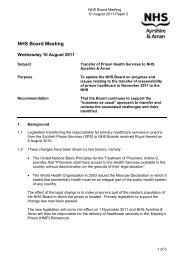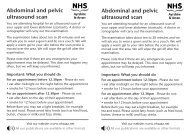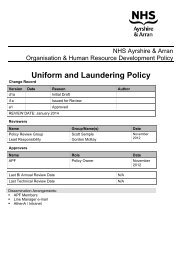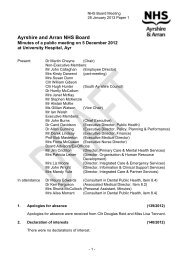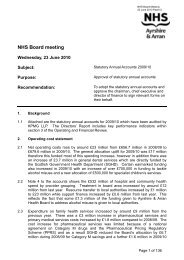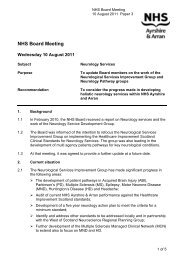Flexible working time and work pattern policy - NHS Ayrshire and ...
Flexible working time and work pattern policy - NHS Ayrshire and ...
Flexible working time and work pattern policy - NHS Ayrshire and ...
You also want an ePaper? Increase the reach of your titles
YUMPU automatically turns print PDFs into web optimized ePapers that Google loves.
Debit or credit up to 8 hours may be carried forward to the next settlement period. Duringthe settlement period a whole day or 2 half days may be taken off in lieu of creditaccumulated or in anticipation of credit to be accumulated during the settlement period.Prior notice of <strong>time</strong> off in lieu is required in order that staffing levels can be maintained.September 2008 7
SECTION 3 – COMPRESSED WORKING WEEK1. Policy statement<strong>NHS</strong> <strong>Ayrshire</strong> <strong>and</strong> Arran is committed to staff being given the opportunity of balancinghome <strong>and</strong> <strong><strong>work</strong>ing</strong> life <strong>and</strong> therefore supports the principle of compressed <strong><strong>work</strong>ing</strong> week inorder to meet the needs of both staff <strong>and</strong> the Organisation.2. DefinitionCompressed <strong><strong>work</strong>ing</strong> week is a system whereby staff are allowed to 'compress' some oftheir <strong><strong>work</strong>ing</strong> weeks into fewer full <strong><strong>work</strong>ing</strong> days, without reducing the total number ofhours. This system is a variation on flexible <strong><strong>work</strong>ing</strong> hours.The compressed <strong><strong>work</strong>ing</strong> week <strong>policy</strong> is intended primarily to provide staff with theopportunity to <strong>work</strong> flexibly, by balancing their <strong><strong>work</strong>ing</strong> hours with family, leisure <strong>and</strong> othercommitments. It allows staff the ability to compress the <strong><strong>work</strong>ing</strong> week <strong>and</strong> also to meet theservice dem<strong>and</strong> at the busy <strong>time</strong>s of the week.3. ResponsibilityIt is the responsibility of both staff <strong>and</strong> line management to ensure that arrangements arein place to support the <strong>policy</strong>. Staff must have their hours agreed with their line managerwell in advance.How it <strong>work</strong>sWhilst there is no st<strong>and</strong>ard <strong><strong>work</strong>ing</strong> <strong>pattern</strong> when agreeing a Compressed Working Week(or fortnight) an example would be where a full-<strong>time</strong> employee might compress their hoursinto four days rather than five; or into nine days out of ten. This gives the employee a dayoff each week or a full day off every fortnight. The hours are agreed with the line managerin advance.Some<strong>time</strong>s a maximum <strong><strong>work</strong>ing</strong> day may be specified, for example, eight or nine hours, toensure staff are fully productive <strong>and</strong> do not attempt to squeeze too many <strong><strong>work</strong>ing</strong> hoursinto each day. Consideration must also be given to compliance with the Working TimeRegulations <strong>and</strong> the maximum hours which can be <strong>work</strong>ed within a <strong><strong>work</strong>ing</strong> day.BenefitsTo the Organisation / Line Manager• Increased employee motivation, leading to better productivity.• Enhance recruitment <strong>and</strong> retention• Resources can be devoted to a busy part of the week.• Reduced need for authorised absences during <strong><strong>work</strong>ing</strong> <strong>time</strong>, e.g. for medicalappointments.• It is a useful system for solving short-term problems.To the Employee• Longer weekend off (depending on agreed <strong><strong>work</strong>ing</strong> <strong>pattern</strong>).September 2008 8
• Larger blocks of family <strong>and</strong> leisure <strong>time</strong>.• Reduced costs such as childcare• Not travelling at peak <strong>time</strong>s due to an extended <strong><strong>work</strong>ing</strong> day.• Less travelling costs if full days are 'saved' <strong>and</strong> staff are travelling off-peak.Points to Consider when Making an Application• May be tiring.• Less leisure <strong>time</strong> during <strong><strong>work</strong>ing</strong> days.• Over<strong>time</strong> is virtually eliminated.• Impact on service delivery.• Impact on colleagues.September 2008 9
SECTION 4 – PART TIME1. Policy Statement<strong>NHS</strong> <strong>Ayrshire</strong> <strong>and</strong> Arran recognises the important role that part-<strong>time</strong> employees can playin the <strong>work</strong>force <strong>and</strong> therefore supports part-<strong>time</strong> <strong><strong>work</strong>ing</strong> in order to meet the needs ofboth staff <strong>and</strong> the Organisation.The Organisation has a large number of part-<strong>time</strong> employees because the posts they holdhave been designated as part-<strong>time</strong> in the establishment. These posts although part-<strong>time</strong>should still allow the holders the right of access to the range of ' <strong>work</strong> life balance' options.This is different from the concept of part-<strong>time</strong> <strong><strong>work</strong>ing</strong> or reduced hours <strong><strong>work</strong>ing</strong> as one ofthe range of options which can be accessed under the banner of ‘<strong>work</strong> life balance’policies.The terms <strong>and</strong> conditions for part <strong>time</strong> staff should be no different to that of otheremployees, other than some of the terms <strong>and</strong> conditions will be on a pro-rata basis.2. Definition of part-<strong>time</strong>Part-<strong>time</strong> <strong>work</strong> is defined as <strong><strong>work</strong>ing</strong> fewer hours than the full-<strong>time</strong> hours for that grade ofstaff.Part-<strong>time</strong> <strong><strong>work</strong>ing</strong> allows employees to reduce their full-<strong>time</strong> hours to less than theirnormal within a range of options i.e. half days, shorter days, a reduced number of full daysor an agreed number of hours in an arranged <strong>pattern</strong>. It should be noted that although anemployee may request to reduce to part-<strong>time</strong> <strong><strong>work</strong>ing</strong> hours this may only be for a specificperiod of <strong>time</strong> <strong>and</strong> may in due course wish to have the option of return to full <strong>time</strong>. Allrequests for part-<strong>time</strong> <strong><strong>work</strong>ing</strong> should be reviewed after a six month period to identifywhether the individual wishes to continue with the part <strong>time</strong> arrangement or return to full<strong>time</strong> <strong>work</strong>. Following the initial review period a further six month part <strong>time</strong> arrangementmay be granted. A review must then occur at the end of the 12 month period to againdiscuss the current <strong><strong>work</strong>ing</strong> arrangements. If following the 12 month period the employeewishes to remain part <strong>time</strong> they will relinquish the automatic right to return to full <strong>time</strong>unless this can be accommodated within the managers existing budget.Definition of V TimeVoluntary reduced <strong><strong>work</strong>ing</strong> means the employee voluntarily reduces their <strong><strong>work</strong>ing</strong> <strong>time</strong> fora specified period, usually to enable them to manage other personal or caringcommitments. Voluntary reduced <strong><strong>work</strong>ing</strong> periods can last anything up to five years,however a period of between six months <strong>and</strong> one year are the most typical.The voluntary reduced <strong><strong>work</strong>ing</strong> <strong>time</strong> scheme is intended primarily to enable employees toreduce their <strong>work</strong> commitment for a defined period, with a corresponding reduction inearnings. Its main aim is to strengthen the loyalty <strong>and</strong> commitment of employees byenabling them to deal with responsibilities outside <strong>work</strong> without having to leave or changeto a part-<strong>time</strong> contract.September 2008 10
Reduced hours <strong>pattern</strong>s enable people to continue to <strong>work</strong> when they are unable to fulfilthe dem<strong>and</strong>s of <strong>work</strong> because of caring <strong>and</strong> other responsibilities.Reorganising hoursReorganising the hours of <strong>work</strong> is a contractual matter between employer <strong>and</strong> employee.(seek further guidance from the department of O&HRD)To comply with the law:• In reorganising <strong>work</strong>loads, part-<strong>time</strong> employees will not be treated less favourablythan full-<strong>time</strong> employees.Promotion for part-<strong>time</strong> employeesPart-<strong>time</strong> employees have equal opportunity to seek promotion.To comply with the law:• Previous or current part-<strong>time</strong> status will not of itself constitute a barrier to promotionto a post, whether the post is full-<strong>time</strong> or part-<strong>time</strong>.• Part-<strong>time</strong> employees will receive the same hourly rate as comparable full-<strong>time</strong>employees.General Guidance.• The form in which an employee takes the reduced <strong>time</strong> is a matter fornegotiation, taking into account the needs of the organisation <strong>and</strong> cannot bevaried except by agreement. At this <strong>time</strong> the duration of the voluntary reductionin <strong><strong>work</strong>ing</strong> hours should be agreed <strong>and</strong> the employee / managers expectationsfor a future return to current <strong><strong>work</strong>ing</strong> hours discussed <strong>and</strong> the process should apotential extension be required.• Pay, benefits <strong>and</strong> holiday entitlements are reduced pro rata.• If employees on Voluntary Reduced Working Time <strong>work</strong> over their agreed hours,these are usually paid at the st<strong>and</strong>ard rate <strong>and</strong> only reach enhanced over<strong>time</strong>rates if they exceed the normal full-<strong>time</strong> hours.• The individual effect on pay, pension <strong>and</strong> benefits of any move to reduced hours<strong><strong>work</strong>ing</strong> should be verified with payroll, the department of Organisation <strong>and</strong>Human Resource Development <strong>and</strong> SPPA.September 2008 11
SECTION 5 – ANNUALISED HOURS1. IntroductionAnnualised hours systems provide a way of organising <strong><strong>work</strong>ing</strong> <strong>time</strong> by contracting withstaff to <strong>work</strong> an agreed number of hours per year rather than a st<strong>and</strong>ard number eachweek. The actual number of hours <strong>work</strong>ed by a member of staff during the week will thenbe “flexed” to match <strong>work</strong>load requirements. As well as hours being varied week to week,they may also be varied seasonally <strong>and</strong>/or according to fluctuation of service dem<strong>and</strong>s.Annualised hours are used to match attendance of staff to the periods when they are mostneeded by services.Fluctuations in hours <strong>work</strong>ed may be predictable or not reflecting the often uncertain<strong>pattern</strong>s of dem<strong>and</strong> for services such as in an acute hospital. Annualised hours <strong><strong>work</strong>ing</strong>can offer a flexible <strong>and</strong> efficient way of deploying staff by matching staffing levels moreclosely with variances in <strong>work</strong>load. For staff, annualised hours <strong><strong>work</strong>ing</strong> offers greaterflexibility <strong>and</strong> the opportunity to better manage <strong><strong>work</strong>ing</strong> hours to allow individuals to tailorthe <strong>time</strong> they spend at <strong>work</strong> <strong>and</strong> at home. For employers, in <strong>time</strong> this can lead toreductions in staffing costs through efficient allocation of staffing levels <strong>and</strong> the reductionof over<strong>time</strong> costs or use of agency or bank staff.Under more traditional <strong><strong>work</strong>ing</strong> arrangements, the dem<strong>and</strong> for services may result inover<strong>time</strong> or premium rates of pay at busy <strong>time</strong>s or overstaffing when dem<strong>and</strong> is low. Withannualised hours, a yearly staff plan is drawn up in advance so that staff know when theyare expected to <strong>work</strong> on a regular basis.Health service employers frequently have to approach bank or agency staff to fill staffinggaps for all types of clinicians. Developing a more flexible approach than the use of bankstaff, such as annualised hours systems, allows rostering which is more responsive topatient needs <strong>and</strong> enable flexible deployment of existing experienced staff to enable shorttermfluctuations in activity to be serviced by meeting peaks <strong>and</strong> troughs in <strong>work</strong>load.Staff costs may be better controlled through the flexibility offered by annualised hours<strong><strong>work</strong>ing</strong> by reducing the cost impact of staff deployment decisions particularly thoseassociated with “inappropriate” use of bank or agency staff, over<strong>time</strong> <strong>and</strong> <strong>time</strong> owed toexisting staff.Annualised hours contracts are equally appropriate for all grades of staff wishing to <strong>work</strong>full-<strong>time</strong> <strong>and</strong> part-<strong>time</strong> hours <strong>and</strong> may be utilised by a small number of staff <strong>and</strong> need notnecessarily involve whole teams.2. ProcedureStaff, their representatives <strong>and</strong> managers in any one area or organisation will haveto identify the best solutions to their own staffing requirements <strong>and</strong> tailor the designof their annualised hours system accordingly. It is essential that staff <strong>and</strong> theirrepresentatives are involved in <strong><strong>work</strong>ing</strong> out the details of the system in order to capitaliseon their knowledge <strong>and</strong> experience <strong>and</strong> to gain ownership <strong>and</strong> underst<strong>and</strong>ing of thesystem.September 2008 12
Information on both patient/service activity <strong>and</strong> staff is required to allow the design of theannualised hours system. In terms of staffing, it will be necessary to collate information onan annual basis to assess how many staff are in post; how they are deployed; assess useof bank/agency staff; turnover; current shift <strong>pattern</strong>s <strong>and</strong> rotas; absence rates <strong>and</strong><strong>pattern</strong>s; <strong>and</strong> staff costs.Data should also be gathered <strong>and</strong> assessed as to whether or not there are peaks ortroughs in activity; against the fluctuations of service dem<strong>and</strong> over a 24 hourperiod/service provision <strong>time</strong>; the extent to which there are high levels of emergencies <strong>and</strong>when they occur; whether or not there are seasonal variations in activity/dem<strong>and</strong>; <strong>and</strong> theextent to which staff costs may be unpredictable.The data considered against these factors will help to inform as to whether or not theexisting system of staff allocation is <strong><strong>work</strong>ing</strong> well <strong>and</strong> supports decision-making as to theneed <strong>and</strong> desirability of proceeding to develop an annualised hours system.3. General Information relating to Terms <strong>and</strong> Conditions with respect to AnnualisedHours• Calculating hours to be <strong>work</strong>edAn employee on an annualised hours contract, would be contracted to <strong>work</strong> anagreed number of hours per year. Salary will be received in 12 equal monthlypayments which will be inclusive of annual leave <strong>and</strong> Public Holiday entitlement.Staff are paid the same monthly salary throughout the year regardless of theexact number of hours they <strong>work</strong> each month.• Normal Agenda for Change Enhancement rates will apply.• Maximum <strong>and</strong> minimum <strong><strong>work</strong>ing</strong> hours per week are also agreed within the 48hours (set by the Working Time Regulations) as the norm for a maximum length of<strong><strong>work</strong>ing</strong> week <strong>and</strong> a minimum to be agreed in line with service needs.• Over the course of a year the number of hours <strong>work</strong>ed overall may vary by plus orminus an agreed number of hours, for example, 30 hours, which can be carriedover to the next year. Staff <strong>and</strong> managers record the number of hours <strong>work</strong>ed byeach member of staff <strong>and</strong> the cumulative totals are regularly monitored to ensurethe account will be kept within the prescribed limits at the end of the year.• Once the full <strong>time</strong> conditioned hours for the post per annum are exceeded st<strong>and</strong>ardover<strong>time</strong> payments will apply.• Staff rotas should be planned to match service dem<strong>and</strong>s/patient need in line withthe analysis undertaken. Exceptionally shift <strong>pattern</strong>s may be changed at shortnotice, giving an agreed minimum notice period, by mutual agreement.• Annual LeaveEmployees will be issued with an annual leave card for the accrued paid hoursincorporated into their equal monthly salary payments <strong>and</strong> should be requested inthe normal way.September 2008 13
• Sickness absenceWhere staff are absent from <strong>work</strong> due to sickness payment will be made on thebasis of normal organisational sick pay rules i.e. full pay or half pay based onaverage monthly earnings.For staff on annualised hours who are off sick, where hours have not been rosteredin advance, the remainder of the annualised hours to be <strong>work</strong>ed for the agreed <strong>time</strong>period will be recalculated on the basis of average hours per month paid as sick<strong>time</strong> balanced against the hours outst<strong>and</strong>ing.4. EvaluationEvaluation of staff <strong>and</strong> managers’ experiences <strong>and</strong> of the effectiveness of the systemwill be undertaken on an ongoing basis in order to inform revisions to the system wherenecessary. Evaluation criteria should be established at the outset <strong>and</strong> will includeassessments of the effectiveness of communication of the scheme, the effectiveness ofthe partnership approach, the difficulties <strong>and</strong> opportunities experienced in running thescheme, the extent to which gaps between staffing <strong>and</strong> <strong>work</strong>load have narrowed,including pressures on staff, the effectiveness <strong>and</strong> quality of patient care, financialperformance <strong>and</strong> the need for bank/agency staff.September 2008 14
SECTION 6 – JOB SHARE1. DefinitionJob sharing is a formal agreement whereby the duties <strong>and</strong> responsibilities of a post can beshared by two or more employees. The salary <strong>and</strong> benefits of the post will be dividedbetween the job share partners in proportion to the number of hours they <strong>work</strong>.As good communication <strong>and</strong> co-operation are required between the job share partners,provision for an overlap may be required to facilitate <strong>and</strong> maintain continuity.2. Objectives• To support the Equal Opportunities Policy <strong>and</strong> Employment Legislation by allowingtheintroduction of flexible <strong><strong>work</strong>ing</strong> practices.• To allow employees the opportunity of applying for a change in their <strong><strong>work</strong>ing</strong><strong>pattern</strong>.• To allow existing job sharing employees to compete for promotional posts.• To provide job share partners with contracts which include specific reference to jobsharing conditions.3. Responsibilities3.1 Job Share PartnersTo ensure that job sharing arrangements do not adversely affect service provision bymaintaining robust communications, <strong>and</strong> providing support for each other.3.2 ManagersTo consider carefully each application to job share <strong>and</strong> wherever possible to facilitate theintroduction of these arrangements.Where job sharing is not feasible to advise employees as to the reason(s) why.Vacant positions should be advertised as open to any c<strong>and</strong>idate to apply on a full-<strong>time</strong> orjob share basis, unless it can be demonstrated that this is inappropriate.C<strong>and</strong>idates will be asked to indicate on their application whether they wish to job share. Allc<strong>and</strong>idates are required to submit an application <strong>and</strong> these will be considered on anindividual basis.Applicants should receive relevant information plus a copy of the job share <strong>policy</strong> ifthey are successfully shortlisted for interview.3.3 Department of Organisation & Human Resource Development (O&HRD)As the department responsible for the <strong>policy</strong>, O&HRD will maintain a job share register.This will provide information on existing <strong>and</strong> potential employees who wish to apply for ajob share.September 2008 15
In the event of an application for a job share being rejected for operational or recruitmentreasons, the applicants will be informed of the register by their line manager <strong>and</strong> asked ifthey wish to be included on the register. The employee will be asked to complete aconsent form to support this.The purpose of the register will be to support employees in their attempt to secure a jobshare position. The department of O&HRD will support the employees but, it will be theindividual’s responsibility to apply for <strong>and</strong> secure the post through the normal recruitmentprocesses. It will not be the organisation’s role to secure posts for employees.Those who ‘register’ will be asked to specify the type of <strong>work</strong> they are interested in <strong>and</strong> the<strong>pattern</strong>s of <strong>work</strong> they would prefer.O&HRD will also support line managers through this process providing advice <strong>and</strong>guidance where necessary.4 Job Share ProcedureJob share partners do not require to state their reasons for wishing to job share.Where an application is approved, an advertisement will be placed for a job share partner,stating clearly that it is a job sharing post.In the case of the Job Share Policy, where an applicant applies for a post <strong>and</strong> expresses awish to job share it should be explained that if successful <strong>and</strong> in the event that theorganisation is unable to find another job share partner, the applicant would be expectedto <strong>work</strong> the contracted hours of the post until such <strong>time</strong>s as a job share partner can befound.If, after advertising twice for a job-sharing partner, the post remains unfilled, managersshould give consideration to alternatives; redeployment, or other arrangements for flexible<strong><strong>work</strong>ing</strong> that may meet the employee’s needs. The employee should also be informed thata new application for job sharing may be considered after the expiry of 12 months from theclosing date of the last advertisement. The organisation will however advertise within 12months if solutions can be found within the job share register or redeployment pool.Until such <strong>time</strong> as a job sharing partner commences employment, the existing employeewill continue to <strong>work</strong> the posts contracted hours.5 General Job Share Information5.1 Job Sharing ArrangementsWorking arrangements can be divided in a number of ways, for example, split days, splitweeks, alternate days or alternate weeks, depending on the nature of the job. Although notexclusively a 50/50 split, cognisance of both professional registration <strong>and</strong> needs of servicemust be taken into account <strong>and</strong> therefore a minimum/maximum number of hours may benecessary to maintain competencies in line with professional guidelines where applicable.The Line Manager must ensure that agreement has been reached between themselves<strong>and</strong> the job sharers on the hours <strong>and</strong> cycle to be <strong>work</strong>ed <strong>and</strong> where appropriate, thedivision of tasks to be undertaken to meet the contracted hours of the post.Any changes to the agreed arrangements will be discussed with the job share partnersSeptember 2008 16
<strong>and</strong> then line manager <strong>and</strong> must be agreed by all before implementation.If no agreement reached then the status quo will remain.As with any other post, alterations due to organisational change will be discussed by theline manager <strong>and</strong> the job share partners.Job sharing partners will have separate contracts of employment sharing the contractedhours of the post.The Job share agreement, which is a written agreement between partners <strong>and</strong> the linemanager will specify the arrangements to allow job share partners to communicate, <strong>and</strong>will clearly indicate if appropriate, which responsibilities are shared <strong>and</strong> which areallocated to individual job share partners.5.2 Replacing job share partnersWhere one job share partner leaves the employment of the organisation the remaining jobshare partner will be offered the post on a full-<strong>time</strong> basis.If the employee prefers the job sharing arrangement, the post will be advertised in themanner outlined in paragraph 4 above. While the post is being advertised the remainingjob sharer may be invited, but not required, to <strong>work</strong> full <strong>time</strong> hours.If after a period of not less than six months <strong>and</strong> advertising at least twice, the post remainsunfilled, every effort will be made to offer an alternative part <strong>time</strong> job. If this is unsuccessfulthen the normal redeployment <strong>policy</strong> would apply.5.3 Individual performance reviewEach job share partner receive individual performance review <strong>and</strong> produce a KSF outlinelinked to a PDP relevant to their needs. The objectives set for the job share partners mayinclude an objective to ensure the success of the job share partnership.5.4 SupervisionEach job share partner will be responsible to the same line manager.5.5 Cover for Leave PurposesWhere one part of a shared post is unoccupied due to sickness, maternity or other leave,the other job share partners may be invited, but not required, to undertake additionalhours.September 2008 17
Section 7 – Working at HomePolicy Statement<strong>NHS</strong> <strong>Ayrshire</strong> <strong>and</strong> Arran is prepared to consider <strong><strong>work</strong>ing</strong> at home to improve retention <strong>and</strong>make reasonable adjustments.This <strong>policy</strong> applies to any post where <strong>work</strong> is performed at or from home instead of atNational Health Service premises for a significant proportion of the contractual <strong><strong>work</strong>ing</strong>hours.Definition"Working at Home" occurs when an employee wishes, with the approval of their manager,to <strong>work</strong> at home for part of their <strong><strong>work</strong>ing</strong> <strong>time</strong> even though their contract of employmentrequires them to be based on <strong>work</strong> premises.GUIDANCE NOTEThe principles <strong>and</strong> parameters must be agreed before a <strong><strong>work</strong>ing</strong> at home scheme can beintroduced, taking note of the following considerations –• Hours of Duty – Hours <strong>work</strong>ed at home will be s agreed with the line manager,taking into account the needs of the service but would normally be a maximum ofone day per week unless otherwise agreed• Working at home should be used to undertake specific <strong>work</strong> activities as agreedwith your line manager.• Frequency <strong>and</strong> duration of <strong><strong>work</strong>ing</strong> at home should be agreed with the manager.• Reasonable notice of a wish to <strong>work</strong> at home must be given in line with thest<strong>and</strong>ard procedure.• Once there is an agreement that an individual is to <strong>work</strong> at home for a part of a day,given day or period of days, the arrangement should be respected in so far aspossible.• Staff <strong><strong>work</strong>ing</strong> at home may be recalled to <strong>work</strong> premises at short notice• In cases where staff <strong><strong>work</strong>ing</strong> at home are frequently recalled to <strong>work</strong> premises atshort notice, <strong><strong>work</strong>ing</strong> arrangements should be reviewed. The situation will initiallybe reviewed after 3 months <strong>and</strong> then annually thereafter or earlier should thecircumstances merit it. Individuals <strong>and</strong> managers should jointly monitor the impactof <strong>time</strong> spent <strong><strong>work</strong>ing</strong> at home. Where an employee <strong>work</strong>s at home more than 50days in any one calendar year the employee’s manager will actively review ways of<strong><strong>work</strong>ing</strong> with particular regard to location of the <strong>work</strong>place.• Staff <strong><strong>work</strong>ing</strong> at home are required to carry out their <strong>work</strong> duties during their normalhours of <strong>work</strong>, unless otherwise agreed. Any domestic arrangements such asSeptember 2008 18
childcare/carer arrangements must remain in place throughout the hours of <strong>work</strong>.Any abuse of the <strong><strong>work</strong>ing</strong> at home system could result in disciplinary action. Staffabusing the system will have the <strong><strong>work</strong>ing</strong> at home arrangement withdrawnimmediately. Managers may request evidence of the <strong>work</strong> carried out.• Staff <strong><strong>work</strong>ing</strong> at home must be contactable by telephone.September 2008 19
SECTION 8 - TEAM BASED SELF ROSTERINGPolicy Statement<strong>Ayrshire</strong> <strong>and</strong> Arran <strong>NHS</strong> (hereinafter referred to as the Organisation) recognises that therigidity of <strong><strong>work</strong>ing</strong> practices has been identified as being one of the prime reasons forleaving the employment of the <strong>NHS</strong>. The Organisation is prepared to consider team-basedself-rostering to improve retention.AimTo allow staff to have more flexibility to plan their <strong>work</strong> around other commitments<strong>and</strong> responsibilities, whilst still meeting the needs of the service.DefinitionSelf-rostering means agreeing the staffing levels <strong>and</strong> skill mix required at any <strong>time</strong> in theday, then giving staff the ability to schedule their <strong><strong>work</strong>ing</strong> day collectively to meet theserequirements.Team-based self-rostering is a "bottom up" approach to scheduling <strong>work</strong>, giving staff morecontrol over the <strong>pattern</strong> of their <strong><strong>work</strong>ing</strong> week. Parameters are set, by agreeing, inadvance, the levels of staff <strong>and</strong> skill mix required hour-by-hour throughout the <strong><strong>work</strong>ing</strong>day.Staff put forward the <strong>time</strong>s they would like to <strong>work</strong> <strong>and</strong> <strong>time</strong>s they would like to protectaway from <strong>work</strong>. This information is then used to compile shift <strong>pattern</strong>s that matchindividual preferences as closely as possible, whilst maintaining agreed levels of cover atall <strong>time</strong>s.Team based self rostering may be used in conjunction with the other flexible <strong><strong>work</strong>ing</strong>policies contained within this document.Team based self rostering <strong>work</strong>s best in a large mixed team where there is a variety ofpersonal circumstances among staff, <strong>and</strong> different preferences about <strong>work</strong> <strong>pattern</strong>s.A recording/rota allocation system should be developed, tailored to the needs of thedepartment, which will produce a roster that matches individual preferences as closely aspossible whilst maintaining the agreed staffing levels. Where there is competition amongtoo many people to <strong>work</strong> at the same <strong>time</strong> - or too few to meet staffing levels at any <strong>time</strong> -the manager will distribute these hours among staff to achieve fairness over the wholeroster period. Assistance can be sought from the Human Resources Department.The system will ensure equity of treatment for all members of the team. Team membersmay negotiate among themselves to modify shifts, but these must be entered into theroster in advance.September 2008 20
Prior to agreement being given to Team Based Self Rostering consideration shouldbe given to:• The level of support among staff for team-based self-rostering.• Any effect on the delivery/continuity of patient care <strong>and</strong> how a gain in quality of care beensured• If it will help to retain existing staff <strong>and</strong> recruit new staff• If it will reduce absences <strong>and</strong> the need for bank or agency staff• If it will affect over<strong>time</strong> or unsocial hours earnings• How h<strong>and</strong>overs will be managed when there aren't clear shift changesThe principles <strong>and</strong> parameters must be agreed before a team-based self-rosteringscheme can be introduced. These will include:• minimum <strong>and</strong> maximum staff levels for each hour of the day.• skill, grade <strong>and</strong> gender mix, hour by hour.• "veto" hours <strong>and</strong> any "core" hours.• the preferences for hours to be <strong>work</strong>ed by each member of the team.• protected <strong>time</strong> periods for each member of the team when they specifically do not wantto <strong>work</strong>.The manager must then compare agreed staffing levels against self-rostered hours <strong>and</strong>take corrective action if there is a mismatch. It might be advisable to trial the self-rosteringscheme for a <strong>time</strong> limited period - three months is the minimum period for the effect to beassessed while six months will provide a better picture of how well it <strong>work</strong>s.Should it be found that Team Based Self Rostering is no longer a viable optionconsideration will be given to reverting to the original rostering process.September 2008 21
TERMS AND CONDITIONS1 Personal AppointmentsAppointments with General Practitioners, Dentists or Opticians will not be treated asauthorised absence <strong>and</strong> must, unless in exceptional circumstances, be arranged out withcore <strong>time</strong> periods.Hospital appointments will continue to be authorised absence within core <strong>time</strong> periods.3.4 Authorised AbsencesFor <strong>Flexible</strong> Working <strong>and</strong> Flexi-Time, absences through sickness, attendance at courses,annual leave <strong>and</strong> other leave of absence with pay will be regarded as the average numberof hours per day, being based on the hours per week being <strong>work</strong>ed over the customarynumber of days per week. The hours of authorised absence should be entered on return.3.5 LeaveFor <strong>Flexible</strong> Working <strong>and</strong> Flexi-Time, annual, compassionate, sick leave etc, <strong>time</strong> will becredited on the record sheet on the basis of the appropriate number of hours absencetaken. For all other applications involving a reduction in hours, annual leave (as applicableto the grade of the post) will be applied on a pro rata basis. Annual leave can be taken atthe same <strong>time</strong> or at different <strong>time</strong>s subject to the manager’s agreement.Arrangements for sharing public <strong>and</strong> statutory holidays will be agreed between the jobshare partners <strong>and</strong> their line manager to ensure that a pro rata division is maintained.3.6 Over<strong>time</strong>Staff requested by their manager to <strong>work</strong> more than their full-<strong>time</strong> hours (or the full <strong>time</strong> equivalentfor part-<strong>time</strong> employees) will be entitled to over<strong>time</strong> rates. Staff may choose either to accrue <strong>time</strong>off in lieu or to claim an over<strong>time</strong> payment. Any <strong>time</strong> off in lieu resulting from over<strong>time</strong> not takenwithin 3 months must be paid as over<strong>time</strong>, in line with <strong>NHS</strong> Terms <strong>and</strong> Conditions of Service.Staff in debit of their flexi <strong>time</strong> will not be entitled to over<strong>time</strong> payments until their debit isaddressed.There will be no requirement on a job share partner to cover for a partner’s short-termabsences, due to sickness or leave. If the individual agrees to <strong>work</strong> such additional hours,then any additional hours <strong>work</strong>ed above those specified in the individual’s personalcontract will be paid at basic rate up to the st<strong>and</strong>ard full <strong>time</strong> contracted hours for the post,thereafter, over<strong>time</strong> rates will apply or <strong>time</strong> off in lieu if agreed.3.7 Part-<strong>time</strong> employeesThis agreement will also apply to part <strong>time</strong> staff with the relevant changes to <strong>work</strong> <strong>time</strong>s.3.8 Pay, pension <strong>and</strong> benefitsSeptember 2008 22
The individual effect on pay, pension <strong>and</strong> benefits of any move to reduced hours <strong><strong>work</strong>ing</strong>should be verified with payroll, the department of Organisation <strong>and</strong> Human ResourceDevelopment <strong>and</strong> SPPA.3.9 Access to trainingAs it can be difficult for part-<strong>time</strong> staff to attend residential courses if they have othercommitments, training should be arranged sympathetically e.g. it would be easier if theywere able to attend courses which run at <strong>time</strong>s when they are normally <strong><strong>work</strong>ing</strong>.• Training should, as far as possible, be arranged to ensure a convenient location<strong>and</strong> timing for part-<strong>time</strong> staff.Part-<strong>time</strong> employees should not lose out in their training simply because of their part-<strong>time</strong>status, <strong>and</strong> the following measures should be considered to support the careerdevelopment.• paying the part-<strong>time</strong> employee (at their normal rate of pay) for the extra hours theyattend outside their normal <strong><strong>work</strong>ing</strong> hours or where agreed <strong>time</strong> off in lieu• offering an equivalent course from an alternative provider at a convenient <strong>time</strong> <strong>and</strong>place• offering other training methods, such as open or distance learning courses.Access to training is essential to ensure that part-<strong>time</strong> employees are <strong><strong>work</strong>ing</strong> effectively.Denying part-<strong>time</strong> employees access to training could lead to a claim of less favourabletreatment.To comply with the law:• Employers should not exclude part-<strong>time</strong> staff from training simply because they<strong>work</strong> part-<strong>time</strong>.In the case of Job Share, training opportunities will be made available to both job sharepartners dependent on their individual needs. When training takes place on a day onwhich one of the job share partners would not normally <strong>work</strong>, <strong>time</strong> off in lieu should beoffered or appropriate payment. If appropriate, job share partners may attend trainingsessions together.3.10 For Job Share:Cover for AbsenceThere will be no requirement on a job share partner to cover for a partner’s short-termabsences, due to sickness or leave. If the individual agrees to <strong>work</strong> such additional hours,then any additional hours <strong>work</strong>ed above those specified in the individual’s personalcontract will be paid at basic rate up to the st<strong>and</strong>ard full <strong>time</strong> contracted hours for the post,thereafter, over<strong>time</strong> rates will apply or <strong>time</strong> off in lieu if agreed.Each job share partner will have an individual contract of employment. All pay <strong>and</strong> otherbenefits will be pro rata to the hours <strong>work</strong>ed. The job title <strong>and</strong> job description for both jobshare partners will be the same.September 2008 23
Grade, Salary <strong>and</strong> IncrementThe grade will apply equally to all job share partners. Any grading review will apply to thewhole post.Salary will be pro rata. Benefits depending on length of service – including incrementalpoints, sick pay, long service leave <strong>and</strong> maternity entitlements – will be attributedindividually.PromotionJob share partners will be considered for advertised vacancies on equal terms asindividuals with all other employees.Each job share partner will have an individual contract of employment. All pay <strong>and</strong> otherbenefits will be pro rata to the hours <strong>work</strong>ed. The job title <strong>and</strong> job description for both jobshare partners will be the same.September 2008 24
STANDARD APPLICATION PROCESSHow to request a change of <strong><strong>work</strong>ing</strong> <strong>time</strong> or <strong><strong>work</strong>ing</strong> <strong>pattern</strong>1 Submitting an applicationAn application to request a change in hours or <strong>work</strong> practice is open to all employees aswell as prospective employees, no matter what level in the organisation. However, thereis no legal right for an employee to change his or her hours or <strong>work</strong> practice.An employee who is considering a change in <strong><strong>work</strong>ing</strong> <strong>time</strong> or <strong><strong>work</strong>ing</strong> <strong>pattern</strong> shouldinitially discuss the matter with their line manager.Following the initial discussion the following procedure must be followed.2 ApplicationIndividuals who wish to apply for any of the schemes available should make a request inwriting, using the application form provided. For Voluntary Reduced Working Timereductions in <strong><strong>work</strong>ing</strong> hours may range up to 50%.All requests for a change of <strong><strong>work</strong>ing</strong> <strong>time</strong> or <strong><strong>work</strong>ing</strong> <strong>pattern</strong>, referring to the appropriate<strong>policy</strong> under which application is being made, should be submitted on the application formattached at Appendix 4.All requests should be made at least three months prior to commencement of theproposed change. However, in exceptional circumstances this may be waived bymanagement. The completed application form should be submitted to the appropriateHead of Department/ Line Manager.The Head of Department/Line Manager will advise the employee, in writing, as to whetherthe post is suitable for application of the requested scheme provisions <strong>and</strong> of any specific<strong>pattern</strong> of <strong><strong>work</strong>ing</strong> which is necessary to make the chosen plan practicable. Theorganisation has a responsibility to treat all employees equally.3 Initial MeetingEach request will be considered on the merits of the individual case <strong>and</strong> a decision madeas soon as reasonably practicable but must be within a period of four weeks (28 calendardays) following receipt of the application. There may be a need to discuss tasks <strong>and</strong>responsibilities <strong>and</strong> how the requested change can fit into the wider team. The linemanager will hold a meeting with the employee to discuss the application. This mayrequire the manager along with the employee to invest <strong>time</strong> <strong>and</strong> effort in order to <strong>work</strong> outan arrangement which suits both the Department <strong>and</strong> the employee.The manager will inform the employee in writing of the outcome of the meeting within 2weeks (14 calendar days).All <strong>time</strong> limits expressed in this procedure are maximum. However, all applications will bedealt with as quickly as possible <strong>and</strong> both parties shall endeavour to reach agreement atan early stage in the procedure. In exceptional circumstances the four week period can beSeptember 2008 25
extended with the agreement of both parties, but it is in everyone’s interest to resolvematters at the earliest opportunity.4 Request grantedRequests for access to a change in <strong><strong>work</strong>ing</strong> hours or <strong>work</strong> <strong>pattern</strong> should be granted withdue consideration to the needs of the service <strong>and</strong> the department. If the request is grantedthe line manager must confirm this in writing, clearly detailing the new <strong><strong>work</strong>ing</strong> <strong>pattern</strong>.5 Request unsuccessfulIf the application is rejected, full details will be provided, in writing, clearly stating thereasons for rejection. An application should only be rejected where there are validsustainable service provision or organisational reasons to do so.The list below provides examples of sustainable reasons for refusal of a request :• Additional costs• Detrimental effect on ability to meet customer dem<strong>and</strong>• Inability to reorganise <strong>work</strong> among existing staff• Inability to recruit additional staff• Detrimental impact on quality• Detrimental impact on performance• Insufficiency of <strong>work</strong> during the <strong>time</strong> the employee proposes to <strong>work</strong>• Planned structural changes• Adequate cover could be difficult to maintain, so popular days off must be fairlydistributed• Not all staff will be able to <strong>work</strong> a longer day because of the nature of the job e.g.receptionists• Potential for multiple requests to be madePlease note that this is list is not exhaustive <strong>and</strong> is only for guidance purposes. Advice <strong>and</strong>guidance should be sought from the department of O&HRD.6 Appeal ProcedureThe employee on receiving confirmation that either their request has been rejected orthe Line Manager’s proposes a compromise alternative may lodge an appeal to theSenior Manager to whom the Line Manager is responsible. Any appeal should belodged within 14 days of receipt of written confirmation of the Line Manager’s decision.The Appeal Hearing - The Senior Manager will hear the appeal within 28 days ofreceiving written notification of the employee’s request to appeal.The Senior Manager hearing the appeal may request a written statement of case inrespect of the matter from both management <strong>and</strong> the employee. Such statement’s willin turn be submitted by all parties to, <strong>and</strong> circulated by the O&HRD representativeattending the appeal hearing. Both parties will be given the opportunity to present theirstatement of case <strong>and</strong> ask questions of the other party.The employee has the right to be accompanied at the appeal meeting by theirSeptember 2008 26
Professional / Trade Union Representative or by a <strong>work</strong> colleague. A member of theDepartment of O&HRD should also be present to ensure fairness <strong>and</strong> consistencythroughout the organisation <strong>and</strong> where required provide advice on the procedure, local<strong>and</strong> national agreements <strong>and</strong> employment legislation.A hearing will not be required where, within 2 weeks of the appeal being lodged, thematter has been satisfactorily resolved informally.7 Resolution of disagreementNo request under these policies will be unreasonably withheld. Should a disagreementarise, the individual has the right to raise a formal grievance. It may be preferable in suchcircumstances, however, for the manager to seek advice on resolving the matter from anappropriate member of the O&HRD Team <strong>and</strong> a Staff Side Representative.The ‘status quo’ will be applied where an application is lodged which pertains to a changein the employee’s <strong><strong>work</strong>ing</strong> arrangements. The <strong><strong>work</strong>ing</strong> arrangements that were in placeprior to the change/proposed change will be reinstated/retained <strong>and</strong> maintained until thegrievance procedure has been exhausted. However, in exceptional circumstances the‘status quo’ may be set aside when both parties reach agreement to do so or, where thecontinuation of the status quo would result in a breach of statutory or other m<strong>and</strong>atoryregulations.8. Duration of ChangeAny mutually agreed change in <strong><strong>work</strong>ing</strong> practice, unless stipulated otherwise at thecommencement of the change i.e. for a fixed term period, is permanent <strong>and</strong> there is noautomatic right for the employee to return to his or her previous terms <strong>and</strong> conditions oncea change has been agreed.9 Abuse of flexible <strong><strong>work</strong>ing</strong> arrangementsAny abuse of the chosen scheme provisions may be viewed as alleged misconduct <strong>and</strong>the organisation will deal with this situation in accordance with the Management ofEmployee Conduct Policy. Staff abusing the system will have the scheme provisionswithdrawn immediately.10 ReviewThis <strong>policy</strong> will be monitored <strong>and</strong> reviewed on a two yearly basis to review its utilisation<strong>and</strong> impact on service provision.September 2008 27
Appendix 1ANNUALISE HOURS WORKEDHOURS WORKED PER WEEKTERM TIME AGENDA FOR CHANGE – WHOLE YEARNUMBER OF WEEKS WHICH WILL BE WORKEDANNUAL HOURSAVERAGE HOURS PER WEEKADDANNUAL LEAVE HOURS PER ANNUMPUBLIC HOLIDAY HOURS PER ANNUMTOTAL PER ANNUMTOTAL LEAVE ADJUSTED TO COUNT ANNUALLEAVE AND PUBLIC HOLIDAY TIME DUE ASACCRUING FOR ANNUAL LEAVE PER ANNUMLEAVE PER WEEKnumber of hours per week x number ofweeks <strong>work</strong>ed to give the number of hours<strong>work</strong>ed per annum OR can be the numberof hours <strong>work</strong>ed per day <strong>time</strong>s the numberof days <strong>work</strong>ed per annumannual hours divided by 52.143 weeks perannum to give average hours per weekannual leave for average hours per week -take from AFC annual leave chartpublic holiday hours for average hours perweek - take from AFC public holiday chartadjust annual leave figure taking intoaccount that the annual leave <strong>and</strong> publicholiday entitlement counts towards accrual= (total annual leave <strong>and</strong> public holidayfigure divided by the annual hours) x(annual hours + total annual leave <strong>and</strong>public holiday hours)TOTAL HOURS PER WEEK TO BE PAID,INCLUSIVE OF A/L & PHAn electronic copy, with <strong>work</strong>able formulae, which will automatically calculate the totalhours per week to be paid, inclusive of annual leave <strong>and</strong> public holiday <strong>time</strong>, is availablefrom the Department of Organisation <strong>and</strong> Human Resource Development.September 2008 28
TERM TIME AGENDA FOR CHANGE – PART YEARANNUALISE HOURS WORKED - PART YEARHOURS WORKED PER WEEKNUMBER OF WEEKS WHICH WILL BE WORKED IN THE TIMEPERIODHOURS WORKED IN TIME PERIODNUMBER OF WEEKS IN TIME PERIODAVERAGE HOURS PER WEEKADDANNUAL LEAVE HOURS PER ANNUMNUMBER OF DAYS IN TIME PERIODANNUAL LEAVE HOURS FOR THE TIME PERIODNUMBER OF PUBLIC HOLIDAYS FALLING WITHIN THE TIMEPERIODAVERAGE HOURS PER DAYPUBLIC HOLIDAY HOURS FOR THE TIME PERIODTOTAL FOR THE TIME PERIODTOTAL LEAVE ADJUSTED TO COUNT ANNUAL LEAVE ANDPUBLIC HOLIDAY TIME DUE AS ACCRUING FOR ANNUALLEAVE PER ANNUMLEAVE PER WEEKnumber of hours per week xnumber of weeks <strong>work</strong>ed to givethe number of hours <strong>work</strong>ed forthe <strong>time</strong> period OR can be thenumber of hours <strong>work</strong>ed per day<strong>time</strong>s the number of days <strong>work</strong>edfor the <strong>time</strong> periodhours <strong>work</strong>ed during the <strong>time</strong>period divided by number ofweeks in the <strong>time</strong> period to giveaverage hours per weekannual leave for average hoursper week - take from AFC annualeave chart x number of days in<strong>time</strong> period/365public holiday hours for averagehours per week - take from AFCpublic holiday chartadjust annual leave figure takinginto account that the annual leave<strong>and</strong> public holiday entitlementcounts towards accrual = (totalannual leave <strong>and</strong> public holidayfigure divided by the annualhours) x (annual hours + totalannual leave <strong>and</strong> public holidayhours)TOTAL HOURS PER WEEK TO BE PAID, INCLUSIVE OF A/L &PHAn electronic copy, with <strong>work</strong>able formulae, which will automatically calculate thetotal hours per week to be paid, inclusive of annual leave <strong>and</strong> public holiday <strong>time</strong>, isavailable from the Department of Organisation <strong>and</strong> Human Resource Development.Draft August 200829
Appendix 2FLEXIBLE WORKING HOURS/FLEXI TIMEATTENDANCE RECORD SHEETName………………………..4 week period From………......... To……………….Morning Afternoon Total Hours WorkedStart Time Finish Start Time FinishWeek 1TimeTime Hours MinsMonHours in credit/debitTues…………………….WedThurs Hours Worked …….FriSat Total Hours …….SunTotal Hours +/- …….Morning Afternoon Total Hours WorkedStart Time Finish Start Time FinishWeek 2TimeTime Hours MinsMonHours in credit/debitTues……………………….WedThurs Hours Worked …….FriSat Total Hours …….SunTotal Hours +/- …….Morning Afternoon Total Hours WorkedStart Time Finish Start Time FinishWeek 3TimeTime Hours MinsMonHours in credit/debitTues……………………….WedThurs Hours Worked …….FriSat Total Hours …….SunTotal Hours +/- …….Morning Afternoon Total Hours WorkedStart Time Finish Start Time FinishWeek 4TimeTime Hours MinsMonHours in credit/debitTues……………………….WedThurs Hours Worked …….FriSat Total Hours …….SunTotal Hours +/- …….Hours in credit/debit ………… to be carried forward to next <strong>time</strong> periodSignature of Employee …………………………Certified by Manager …………………………..Date…………………………Draft August 2008 30
JOB SHARE PROCESS FLOW CHARTAppendix3Applicaton from EmployeeConsideration by Line ManagerSuccessfulUnsuccessfulJob Advertised as Job ShareReasons given in writing to EmployeeExisting Employee <strong>work</strong>s normalcontracted hoursEmployee placed on Job ShareRegister if so wishesAppointmentMay ask for alternatives such as P/T,<strong>Flexible</strong> <strong><strong>work</strong>ing</strong>Agree Job Share Agreement &Objectives by Job Sharers <strong>and</strong> LineManagerRe-apply for Job Share in 12 monthsReviewed as appropriateDraft August 2008 31
APPLICATION FOR A CHANGE TO WORKING HOURS/ WORK PATTERNTo be completed by EmployeeFull Name ………………………………………………………………Post Held ………………………………………………………………Location ………………………………………………………………Ward/Dept ………………………………………………………………Appendix 4Application made under the FLEXIBLE/ FLEXI TIME / TERM TIME/ PART TIME/ SCHOOLTIME/COMPRESSED HOURS/ANNUALISED HOURS/ ZERO HOURS/ WORKING AT HOMEPolicy **I wish to make a request for the following change to my <strong><strong>work</strong>ing</strong> <strong>time</strong>/<strong>pattern</strong>:(please give details of request)with effect from ……………. <strong>and</strong> underst<strong>and</strong> that I will require to discuss how the change inhours will impact on service delivery. I accept that this would necessitate a permanent changeto my contractual terms <strong>and</strong> conditions of employment.Signed ………………………………………….. Date ……………………...HEAD OF DEPARTMENT/LINE MANAGERApproved/Rejected (delete as appropriate)**I support this application <strong>and</strong> confirm that this post is suitable for the change of <strong><strong>work</strong>ing</strong>hours/<strong>pattern</strong> requested/compromise agreement reached (please detail)…………………………………………………………………………………………………………………………………………………………………………………………………………………....**I do not support this application. The reason/s for rejection are:……………………………………………………………………………………………………………………………………………………………………………………………………………………Signed ……………………………………………. Date ………………………Job title:…………………………………………… Location:……………………………………..** Delete as applicableDraft August 200832
Draft May 2008 33






